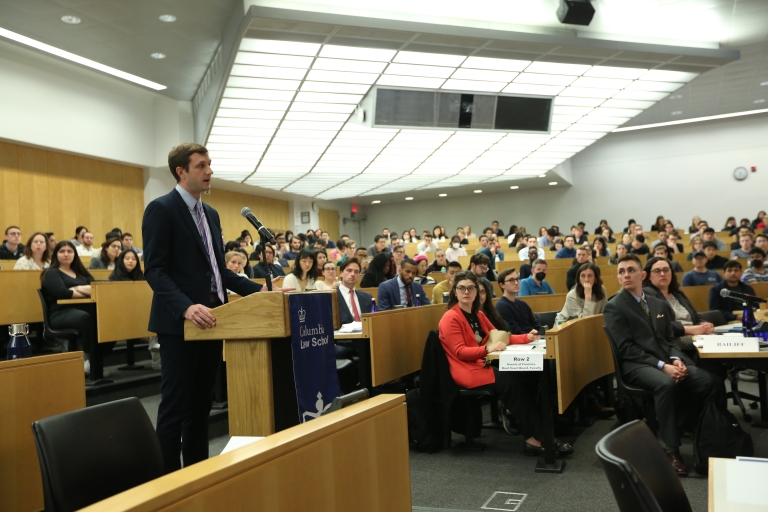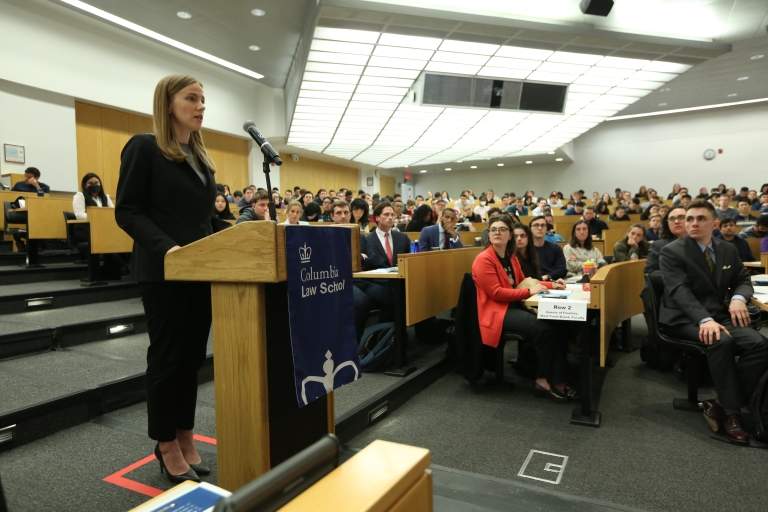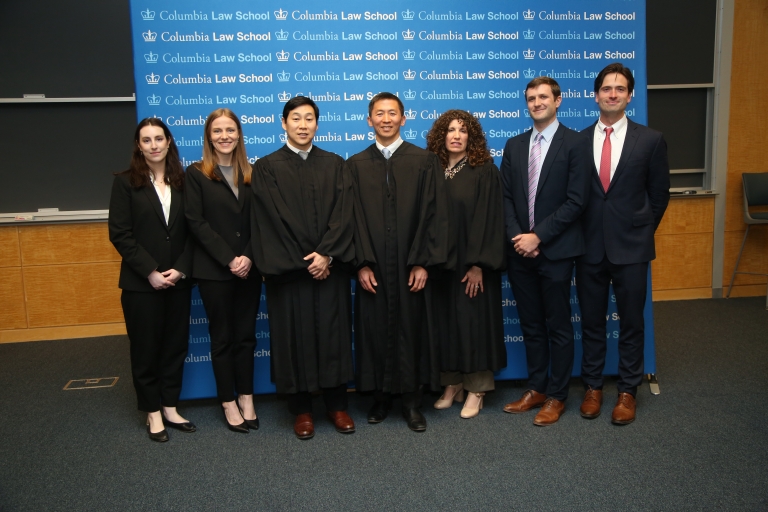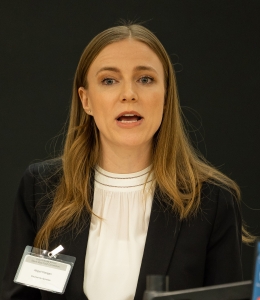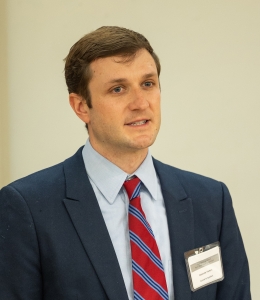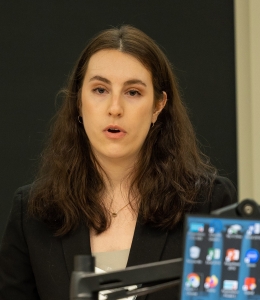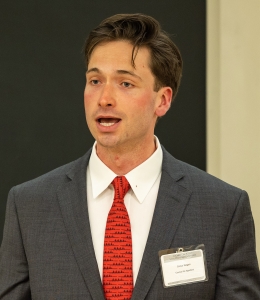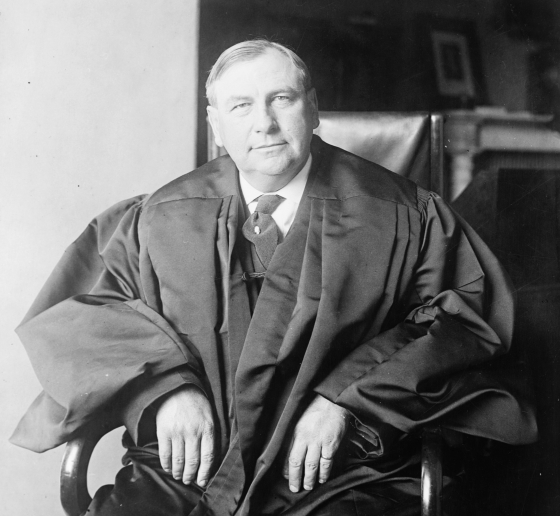Students Confront Federal Indian Law and Sentencing Guidelines in 2023 Harlan Fiske Stone Moot Court Finals
On March 27, Alex Herkert ’23 won the prize for top oralist, and Abigail K. Flanigan ’23 was recognized for best final round brief.
Four Columbia Law School students faced off before a panel of federal judges in the 98th annual Harlan Fiske Stone Moot Court Competition finals on March 27, giving their best answers to questions about whether marijuana-related state convictions are “controlled substance offenses” and how to determine whether a person qualifies as “Indian” under the 1885 Major Crimes Act. The fictional case was written by two former finalists, Parker M. Chusid ’23 and Ninoslav K. Dickersin ’23, who competed against each other in the 2022 finals. (Watch the competition above and read more from the organizers about the case below.)
“Generally, our experience as Moot Court finalists allowed us to understand what kind of legal questions would prove most engaging for the competitors, and what details needed to be provided in the record to allow for effective and interesting briefing and oral argument on the issues,” said Dickersin.
Chusid and Dickersin said they came up with the idea based in part on Chusid’s experience as a 1L in the National Native American Law Students Association moot court. “That experience gave me the confidence to delve into the Major Crimes Act and to leverage the distinction between federal- and state-recognized tribes,” Chusid said.
The pair first considered ambiguities in the law and looked for circuit splits. “Eventually, we settled on the two questions at issue in the case,” said Dickersin. “We then determined how to combine them into a single problem, and identified the 6th Circuit as a jurisdiction where that problem might naturally arise and maximize the degree of thoughtful legal analysis required from the competitors.”
They divided the workload, each focusing on one issue. Ultimately, their case included a number of complicating factors and raised questions concerning tribes’ ability to determine their own membership even where that decision includes a consideration of race, a key issue raised by Brackeen v. Haaland, currently pending before the U.S. Supreme Court.
The competitors delivered their arguments before a panel of distinguished judges: California Supreme Court Justice Goodwin H. Liu and Judges Michael H. Park and Myrna Pérez ’03 of the U.S. Court of Appeals for the 2nd Circuit.
William Joseph Wood v. United States of America
In the final arguments, Alex Herkert ’23 and Conor J. Regan ’23 represented the appellant, William Joseph Wood, who challenged on appeal the jury instructions leading to his designation as an Indian under the law, which gives the federal government jurisdiction over certain criminal cases if the defendant is Native American. Wood also appealed his 10-year sentence for assault with a dangerous weapon as a “career offender” under the Federal Sentencing Guidelines based on two prior marijuana-related convictions in South Dakota. Abigail K. Flanigan ’23 and Julia Konstantinovsky ’24 represented the United States government.
On appeal, Wood argued his prior marijuana-related convictions should not count as “controlled substance offenses” under the federal Controlled Substances Act because the state where he was convicted—South Dakota—did not consider marijuana a controlled substance. Wood also argued that he is not an Indian under the Major Crimes Act. The government argued he is, based on the “totality of circumstances”—Wood’s mother was an enrolled member of a Michigan-recognized tribe (the Burt Lake Band of Ottawa and Chippewa Indians); Wood was once an enrolled member through marriage of a federally designated tribe (the Saginaw Chippewa Indian Tribe); and he continued to work for a casino on the latter tribe’s reservation even after he was disenrolled following his divorce.
In oral arguments, Herkert kicked things off for Wood. He argued that the first part of the two-pronged jury instructions on how to determine whether someone is an Indian under the Major Crimes Act improperly conflated Indian status with race. The second part, Herkert said, was overly broad because it requires affiliation with a federally recognized tribe “at or around” the time of the offense.
The instructions “allowed a person like William Wood, who is not descended from or recognized by or eligible for membership in a federally recognized tribe,” to be convicted under the law, Herkert said.
When Konstantinovsky took the podium, the judges pressed her on that point, asking what would constitute “affiliation” under the instructions.
“Affiliation is a pretty weak word, encompassing a very broad range of relationships,” Liu said. “How is the jury to know where along that spectrum the requisite affiliation is met? Is his employment [for the Saginaw Chippewa casino] sufficient?”
“The government would not necessarily agree that employment alone is sufficient,” Konstantinovsky answered.
“Did the jury know this?” Liu asked.
Regan argued for Wood on the question of the sentencing enhancement for career offender status. Pérez suggested his position on the definition of a “controlled substance” was in line with the 2nd Circuit’s holding in a 2018 case called United States v. Townsend.
“And that was the 2nd Circuit’s Townsend approach?” she asked.
“Absolutely,” Regan said, and then added, “And we would encourage this court to follow the 2nd Circuit’s use of the Controlled Substances Act. A lot of wise judges on that bench.” (Pérez sits on the 2nd Circuit.)
But, when it was her turn to argue, Flanigan urged the judges to apply the “ordinary meaning” of the term “controlled substance” to find that Wood’s marijuana-related convictions qualified him for career offender status.
“This provision is intended to punish people who have broken the law, and if a state chooses to make that a crime . . . it’s appropriate that the federal sentencing guidelines would reflect that,” she said.
The Results
After more than an hour of arguments, the judges left the room to deliberate. When they returned, they delivered the results: Herkert was awarded the Lawrence S. Greenbaum Prize for best oral presentation, and Flanigan won best final round brief.
The judges praised the finalists for their work and effort.
“I was so proud of every one of you,” Liu said. “I thought, ‘If this is what the profession is going to look like, we are going to be in very good shape.’”
Pérez told the students to remember that being a lawyer is called “the practice of law.”
“You’re supposed to practice,” she said. “The idea that you’re up here talking and engaging, I hope, was really meaningful. . . . If you’re not constantly growing as a lawyer, you’re going to get bored; you’re going to be missing out on a lot of opportunities.”
The judges also marveled at the case.
“Every time I thought I had a grasp on one issue, there was another issue around the corner,” Park said.
Dickersin, who also served as bailiff in this year’s competition, said he and Chusid benefited from their own experience as finalists in the 2022 Harlan Fiske Stone Moot Court Competition.
“That allowed us to understand what kind of legal questions would prove most engaging for the competitors,” he said.
The three-round Harlan Fiske Stone Moot Court Competition began in the fall, with 16 students advancing to the semifinals. After the competition, Philip M. Genty, Everett B. Birch Innovative Teaching Clinical Professor in Professional Responsibility and vice dean for experiential education, thanked the judges, the students, and everyone who helped put the program together, including Director of Legal Writing and Moot Court Programs Sophia Bernhardt and the moot court board. In addition to Chusid and Dickersin, this year’s board included Executive Director Angel (Shuman) Li ’23, First-Year Program Director Callie Maslowsky ’23, and Specialized Moot Court Programs Director Saisha Mediratta ’23.
Flanigan said she was “excited and honored” to win the best brief, which is awarded by the student board in consultation with the judges.
“After three rounds of rewriting, I’ve sharpened it to a point that I feel proud of, so it was gratifying to know that the judges felt that it was well done,” she said.
Herkert said it was “an incredible experience to argue in front of such impressive judges.”
“I am very honored that the judges thought highly of my argument,” he said. “It was a great capstone to my moot court journey.”
